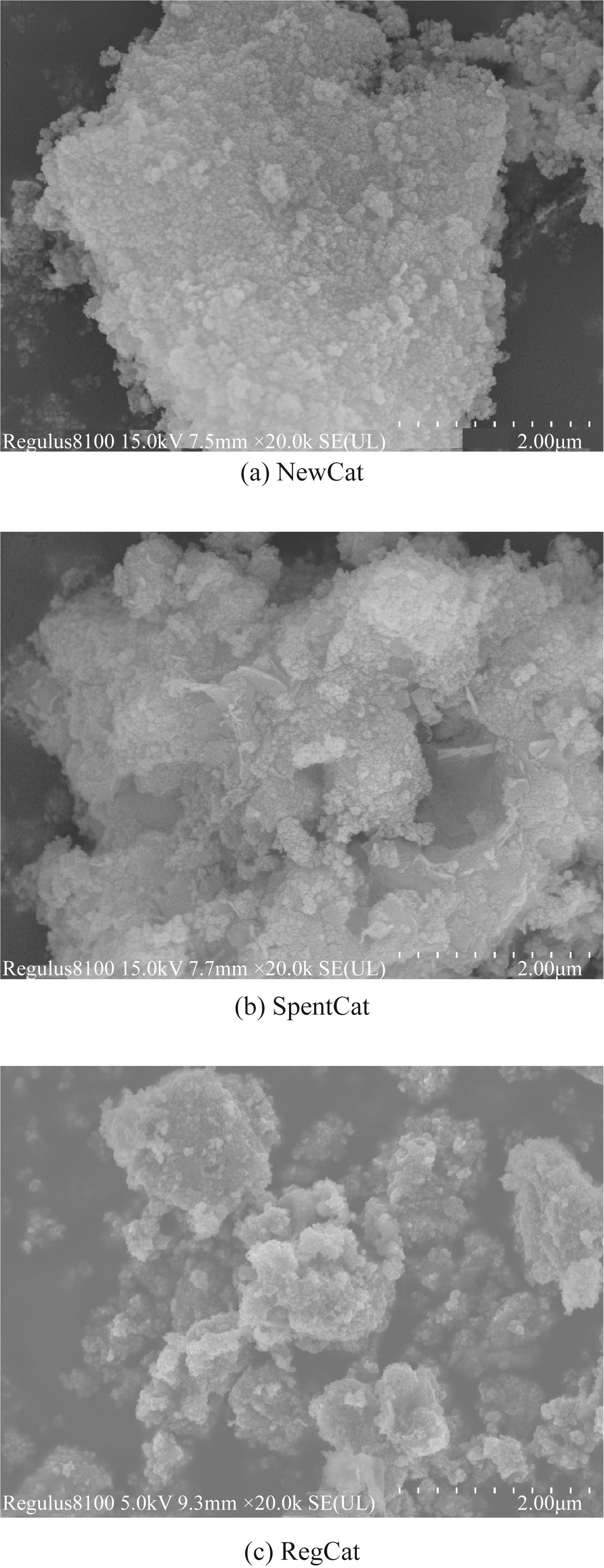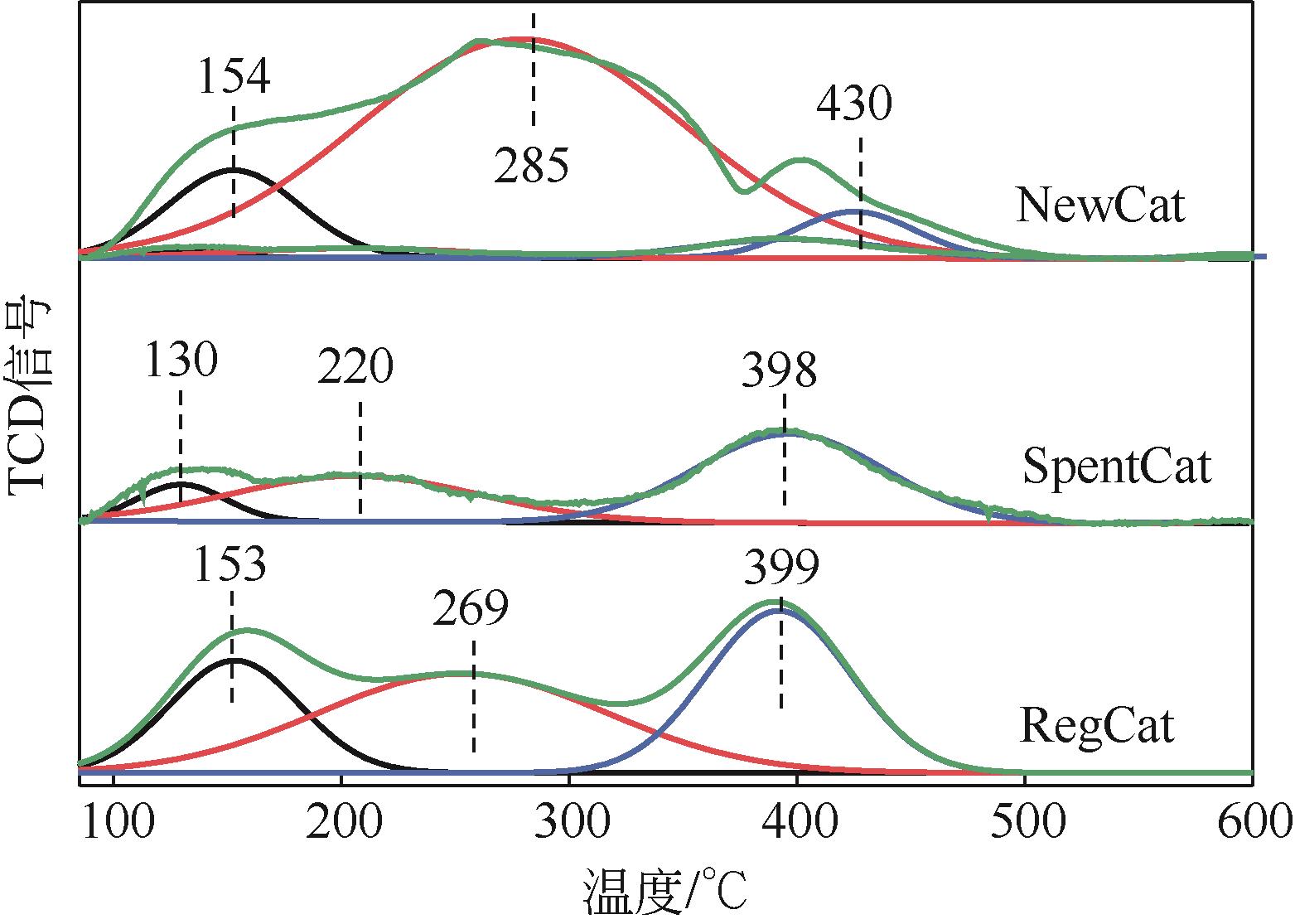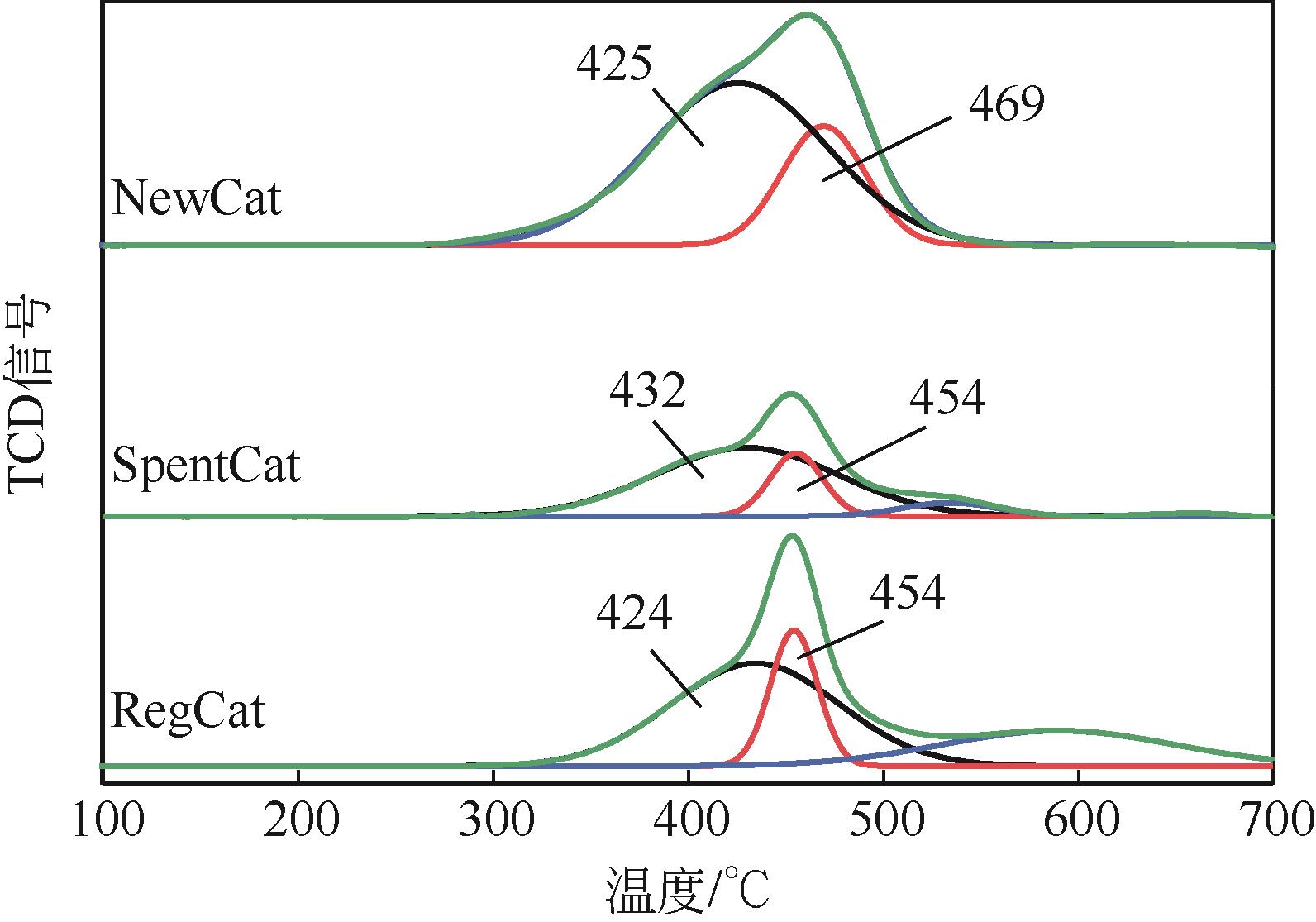Chemical Industry and Engineering Progress ›› 2023, Vol. 42 ›› Issue (5): 2413-2420.DOI: 10.16085/j.issn.1000-6613.2022-1392
• Industrial catalysis • Previous Articles Next Articles
Characteristics of calcium and magnesium deactivation and regeneration of waste incineration SCR catalyst
HE Chuan1( ), WU Guoxun1, LI Ang1, ZHANG Fajie1, BIAN Zijun1, LU Chengzheng1, WANG Lipeng1, ZHAO Min2
), WU Guoxun1, LI Ang1, ZHANG Fajie1, BIAN Zijun1, LU Chengzheng1, WANG Lipeng1, ZHAO Min2
- 1.Xi’an Thermal Power Research Institute Co. , Ltd. , Suzhou Branch, Suzhou 215153, Jiangsu, China
2.Huaneng International Power Co. , Ltd. , Dezhou Power Plant, Dezhou 253006, Shandong, China
-
Received:2022-07-25Revised:2022-10-11Online:2023-06-02Published:2023-05-10 -
Contact:HE Chuan
垃圾焚烧脱硝催化剂钙镁失活与活性恢复特性
何川1( ), 吴国勋1, 李昂1, 张发捷1, 卞子君1, 卢承政1, 王丽朋1, 赵民2
), 吴国勋1, 李昂1, 张发捷1, 卞子君1, 卢承政1, 王丽朋1, 赵民2
- 1.西安热工研究院有限公司苏州分公司,江苏 苏州 215153
2.华能国际电力股份有限公司德州电厂,山东 德州 253006
-
通讯作者:何川 -
作者简介:何川(1988—),男,博士,高级工程师,主要研究方向为大气污染物控制。E-mail:hechuan3333@126.com。 -
基金资助:西安热工研究院有限公司自立科技项目(GU-21-TYK22)
CLC Number:
Cite this article
HE Chuan, WU Guoxun, LI Ang, ZHANG Fajie, BIAN Zijun, LU Chengzheng, WANG Lipeng, ZHAO Min. Characteristics of calcium and magnesium deactivation and regeneration of waste incineration SCR catalyst[J]. Chemical Industry and Engineering Progress, 2023, 42(5): 2413-2420.
何川, 吴国勋, 李昂, 张发捷, 卞子君, 卢承政, 王丽朋, 赵民. 垃圾焚烧脱硝催化剂钙镁失活与活性恢复特性[J]. 化工进展, 2023, 42(5): 2413-2420.
share this article
Add to citation manager EndNote|Ris|BibTeX
URL: https://hgjz.cip.com.cn/EN/10.16085/j.issn.1000-6613.2022-1392
| 样品 | BET比表面积/m2·g-1 | 孔容/cm3·g-1 | 平均孔径/nm |
|---|---|---|---|
| NewCat | 95.23 | 0.32 | 13.31 |
| SpentCat | 67.19 | 0.22 | 16.24 |
| RegCat | 88.36 | 0.30 | 14.27 |
| 样品 | BET比表面积/m2·g-1 | 孔容/cm3·g-1 | 平均孔径/nm |
|---|---|---|---|
| NewCat | 95.23 | 0.32 | 13.31 |
| SpentCat | 67.19 | 0.22 | 16.24 |
| RegCat | 88.36 | 0.30 | 14.27 |
| 样品 | 质量分数/% | |||||||
|---|---|---|---|---|---|---|---|---|
| TiO2 | WO3 | V2O5 | CaO | MgO | SO3 | Al2O3 | SiO2 | |
| NewCat | 81.25 | 5.35 | 4.61 | 1.09 | 0.25 | 0.20 | 0.53 | 4.64 |
| SpentCat | 77.01 | 4.26 | 3.50 | 2.87 | 1.27 | 0.93 | 1.92 | 7.02 |
| RegCat | 80.20 | 4.84 | 4.83 | 1.24 | 0.34 | 0.35 | 0.88 | 5.12 |
| 样品 | 质量分数/% | |||||||
|---|---|---|---|---|---|---|---|---|
| TiO2 | WO3 | V2O5 | CaO | MgO | SO3 | Al2O3 | SiO2 | |
| NewCat | 81.25 | 5.35 | 4.61 | 1.09 | 0.25 | 0.20 | 0.53 | 4.64 |
| SpentCat | 77.01 | 4.26 | 3.50 | 2.87 | 1.27 | 0.93 | 1.92 | 7.02 |
| RegCat | 80.20 | 4.84 | 4.83 | 1.24 | 0.34 | 0.35 | 0.88 | 5.12 |
| 1 | 何发泉, 王宝冬, 马少丹, 等. 生物质电厂SCR脱硝催化剂失效及再生研究[J]. 现代化工, 2017, 37(8): 72-76. |
| HE Faquan, WANG Baodong, MA Shaodan, et al. Deactivation mechanism and regeneration of SCR denitration catalyst served in biomass power plant[J]. Modern Chemical Industry, 2017, 37(8): 72-76. | |
| 2 | 朱子晗, 陈卫华, 华银锋, 等. 垃圾焚烧飞灰重金属药剂稳定化研究进展[J]. 化工进展, 2021, 40(11): 6358-6368. |
| ZHU Zihan, CHEN Weihua, HUA Yinfeng, et al. Research progress and consideration on medicament stabilization of heavy metals in waste incineration fly ash[J]. Chemical Industry and Engineering Progress, 2021, 40(11): 6358-6368. | |
| 3 | XIONG S, CHEN J, LIU H, et al. Like cures like: Detoxification effect between alkali metals and sulfur over the V2O5/TiO2 deNO x catalyst[J]. Environmental Science & Technology, 2022, 56(6): 3739-3747. |
| 4 | 能士峰, 刘庆岭, 张旺, 等. 垃圾焚烧SCR脱硝催化剂的研究进展[J]. 现代化工, 2022, 42(2):31-34. |
| NAI Shifeng, LIU Qingling, ZHANG Wang, et al. Research progress on application of SCR denitrification catalyst in waste incineration[J]. Modern Chemical Industry, 2022, 42(2):31-34. | |
| 5 | 邱琪丽, 蒋旭光. 垃圾焚烧飞灰在污染物控制领域中的应用探讨[J]. 化工进展, 2022, 41(7): 3855-3864. |
| QIU Qili, JIANG Xuguang. Application of municipal solid waste incineration fly ash in the field of pollutant control[J]. Chemical Industry and Engineering Progress, 2022, 41(7): 3855-3864. | |
| 6 | 兰馨, 赵玲. SCR催化剂抗碱(土)金属中毒及再生研究进展[J]. 环境化学, 2022, 41(11): 3778-3788. |
| LAN Xin, ZHAO Ling. Research progress on resistance to alkali (alkaline earth) metal poisoning and regeneration of SCR catalysts[J]. Environmental Chemistry, 2022, 41(11): 3778-3788. | |
| 7 | 周学荣, 张晓鹏. SCR催化剂碱(土)金属中毒的研究进展[J]. 化学通报, 2015, 78(7): 590-596. |
| ZHOU Xuerong, ZHANG Xiaopeng. Research progress in alkali metal poisoning of selective catalytic reduction catalysts[J]. Chemistry, 2015, 78(7): 590-596. | |
| 8 | 李可君, 李芳芹, 任建兴, 等. NH3-SCR脱硝催化剂现状及中毒失活现象研究进展[J]. 无机盐工业, 2022, 54(11): 18-24, 51. |
| LI Kejun, LI Fangqin, REN Jianxing, et al. Current situation of NH3-SCR denitration catalyst and research progress on poisoning and deactivation[J]. Inorganic Chemicals Industry, 2022, 54(11): 18-24, 51. | |
| 9 | TANG F, XU B, SHI H, et al. The poisoning effect of Na+ and Ca2+ ions doped on the V2O5/TiO2 catalysts for selective catalytic reduction of NO by NH3 [J]. Applied Catalysis B: Environmental, 2010, 94(1/2): 71-76. |
| 10 | ZHENG Y, GUO Y, WANG J, et al. Ca doping effect on the competition of NH3-SCR and NH3 oxidation reactions over vanadium-based catalysts[J]. The Journal of Physical Chemistry C, 2021, 125(11): 6128-6136. |
| 11 | ZHANG D, WANG C, LIU Q, et al. The combined effects of alkaline-earth metal, SO2 and CO2 on the selective catalytic reduction of NO by NH3 over V2O5-WO3/TiO2 catalyst[J]. Environmental Technology & Innovation, 2019, 14: 100331. |
| 12 | LU Q, ALI Z, TANG H, et al. Regeneration of commercial SCR catalyst deactivated by arsenic poisoning in coal-fired power plants [J]. Korean Journal of Chemical Engineering, 2019, 36(3): 377-384. |
| 13 | QING M, SU S, WANG L, et al. Getting insight into the oxidation of SO2 to SO3 over V2O5-WO3/TiO2 catalysts: Reaction mechanism and effects of NO and NH3 [J]. Chemical Engineering Journal, 2019, 361: 1215-1224. |
| 14 | HE C, SHEN B, CHI G, et al. Elemental mercury removal by CeO2/TiO2-PILCs under simulated coal-fired flue gas[J]. Chemical Engineering Journal, 2016, 300: 1-8. |
| 15 | RAJA S, ALPHIN M S, SIVACHANDIRAN L, et al. TiO2-carbon nanotubes composite supported MnO x -CuO catalyst for low-temperature NH3-SCR of NO: Investigation of SO2 and H2O tolerance [J]. Fuel, 2022, 307: 121886. |
| 16 | HE C, SHEN B, CHEN J, et al. Adsorption and oxidation of elemental mercury over Ce-MnO x /Ti-PILCs[J]. Environmental Science & Technology, 2014, 48(14): 7891-7898. |
| 17 | CHEN L, LI J, GE M. The poisoning effect of alkali metals doping over nano V2O5-WO3/TiO2 catalysts on selective catalytic reduction of NO x by NH3 [J]. Chemical Engineering Journal, 2011, 170(2/3): 531-537. |
| 18 | WANG, P, GAO S, WANG H, et al. Enhanced dual resistance to alkali metal and phosphate poisoning: Mo modifying vanadium-titanate nanotubes SCR catalyst[J]. Applied Catalysis A: General, 2018, 561: 68-77. |
| 19 | SHI X, GUO J, SHEN T, et al. Improvement of NH3-SCR activity and resistance to SO2 and H2O by Ce modified La-Mn perovskite catalyst [J]. Journal of the Taiwan Institute of Chemical Engineers, 2021, 126: 102-111. |
| 20 | HE C, SHEN B, LI F. Effects of flue gas components on removal of elemental mercury over Ce-MnO x /Ti-PILCs[J]. Journal of Hazardous Materials, 2016, 304: 10-17. |
| 21 | 何川, 张发捷, 卞子君, 等. CeO2改性再生SCR催化剂的单质汞氧化特性[J]. 化工进展, 2021, 40(1): 227-233. |
| HE Chuan, ZHANG Fajie, BIAN Zijun, et al. Oxidation of elemental mercury by CeO2 modified regenerated SCR catalyst[J]. Chemical Industry and Engineering Progress, 2021, 40(1): 227-233. | |
| 22 | YE D, QU R, ZHENG C, et al. Mechanistic investigation of enhanced reactivity of NH4HSO4 and NO on Nb- and Sb-doped VW/Ti SCR catalysts[J]. Applied Catalysis A: General, 2018, 549: 310-319. |
| 23 | 王丽霞, 仲兆平, 朱林,等. 铁铈复合选择性催化还原脱硝催化剂的碱金属(钾)中毒机理[J]. 化工进展, 2017, 36(11): 4064-4071. |
| WANG Lixia, ZHONG Zhaoping, ZHU Lin, et al. Alkali metal(potassium)poisoning mechanism of CeFeO x catalysts for selective catalytic reduction of NO x [J]. Chemical Industry and Engineering Progress, 2017, 36(11): 4064-4071. | |
| 24 | LIU J, HE J, MAO D, et al. Research progress in the SO2 resistance of denitration catalysts in low-temperature NH3-SCR reactions[J]. Scientia Sinica Chimica, 2022, 52(4): 536-548. |
| 25 | 尹子骏, 苏胜, 王中辉, 等. 燃煤烟气中SO3与NH4HSO4生成特性及其控制方法研究进展[J]. 化工进展, 2021, 40(4): 2328-2337. |
| YIN Zijun, SU Sheng, WANG Zhonghui, et al. Research progress on the characteristics and control methods of SO3 and NH4HSO4 formation in coal-fired flue gas[J]. Chemical Industry and Engineering Progress, 2021, 40(4): 2328-2337. | |
| 26 | HUANG X, WANG D, ZHAO H, et al. Severe deactivation and artificial enrichment of thallium on commercial SCR catalysts installed in cement kiln[J]. Applied Catalysis B: Environmental, 2020, 277: 119194. |
| [1] | ZHANG Mingyan, LIU Yan, ZHANG Xueting, LIU Yake, LI Congju, ZHANG Xiuling. Research progress of non-noble metal bifunctional catalysts in zinc-air batteries [J]. Chemical Industry and Engineering Progress, 2023, 42(S1): 276-286. |
| [2] | SHI Yongxing, LIN Gang, SUN Xiaohang, JIANG Weigeng, QIAO Dawei, YAN Binhang. Research progress on active sites in Cu-based catalysts for CO2 hydrogenation to methanol [J]. Chemical Industry and Engineering Progress, 2023, 42(S1): 287-298. |
| [3] | XIE Luyao, CHEN Songzhe, WANG Laijun, ZHANG Ping. Platinum-based catalysts for SO2 depolarized electrolysis [J]. Chemical Industry and Engineering Progress, 2023, 42(S1): 299-309. |
| [4] | YANG Xiazhen, PENG Yifan, LIU Huazhang, HUO Chao. Regulation of active phase of fused iron catalyst and its catalytic performance of Fischer-Tropsch synthesis [J]. Chemical Industry and Engineering Progress, 2023, 42(S1): 310-318. |
| [5] | WANG Lele, YANG Wanrong, YAO Yan, LIU Tao, HE Chuan, LIU Xiao, SU Sheng, KONG Fanhai, ZHU Canghai, XIANG Jun. Influence of spent SCR catalyst blending on the characteristics and deNO x performance for new SCR catalyst [J]. Chemical Industry and Engineering Progress, 2023, 42(S1): 489-497. |
| [6] | DENG Liping, SHI Haoyu, LIU Xiaolong, CHEN Yaoji, YAN Jingying. Non-noble metal modified vanadium titanium-based catalyst for NH3-SCR denitrification simultaneous control VOCs [J]. Chemical Industry and Engineering Progress, 2023, 42(S1): 542-548. |
| [7] | CHENG Tao, CUI Ruili, SONG Junnan, ZHANG Tianqi, ZHANG Yunhe, LIANG Shijie, PU Shi. Analysis of impurity deposition and pressure drop increase mechanisms in residue hydrotreating unit [J]. Chemical Industry and Engineering Progress, 2023, 42(9): 4616-4627. |
| [8] | WANG Jingang, ZHANG Jianbo, TANG Xuejiao, LIU Jinpeng, JU Meiting. Research progress on modification of Cu-SSZ-13 catalyst for denitration of automobile exhaust gas [J]. Chemical Industry and Engineering Progress, 2023, 42(9): 4636-4648. |
| [9] | WANG Peng, SHI Huibing, ZHAO Deming, FENG Baolin, CHEN Qian, YANG Da. Recent advances on transition metal catalyzed carbonylation of chlorinated compounds [J]. Chemical Industry and Engineering Progress, 2023, 42(9): 4649-4666. |
| [10] | ZHANG Qi, ZHAO Hong, RONG Junfeng. Research progress of anti-toxicity electrocatalysts for oxygen reduction reaction in PEMFC [J]. Chemical Industry and Engineering Progress, 2023, 42(9): 4677-4691. |
| [11] | GE Quanqian, XU Mai, LIANG Xian, WANG Fengwu. Research progress on the application of MOFs in photoelectrocatalysis [J]. Chemical Industry and Engineering Progress, 2023, 42(9): 4692-4705. |
| [12] | WANG Weitao, BAO Tingyu, JIANG Xulu, HE Zhenhong, WANG Kuan, YANG Yang, LIU Zhaotie. Oxidation of benzene to phenol over aldehyde-ketone resin based metal-free catalyst [J]. Chemical Industry and Engineering Progress, 2023, 42(9): 4706-4715. |
| [13] | GE Yafen, SUN Yu, XIAO Peng, LIU Qi, LIU Bo, SUN Chengying, GONG Yanjun. Research progress of zeolite for VOCs removal [J]. Chemical Industry and Engineering Progress, 2023, 42(9): 4716-4730. |
| [14] | XIANG Yang, HUANG Xun, WEI Zidong. Recent progresses in the activity and selectivity improvement of electrocatalytic organic synthesis [J]. Chemical Industry and Engineering Progress, 2023, 42(8): 4005-4014. |
| [15] | WANG Yaogang, HAN Zishan, GAO Jiachen, WANG Xinyu, LI Siqi, YANG Quanhong, WENG Zhe. Strategies for regulating product selectivity of copper-based catalysts in electrochemical CO2 reduction [J]. Chemical Industry and Engineering Progress, 2023, 42(8): 4043-4057. |
| Viewed | ||||||
|
Full text |
|
|||||
|
Abstract |
|
|||||








